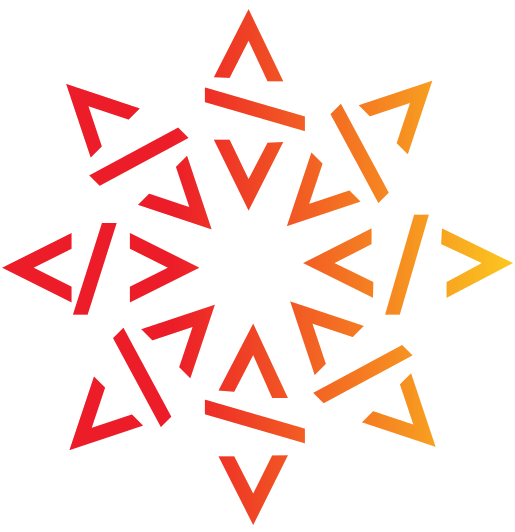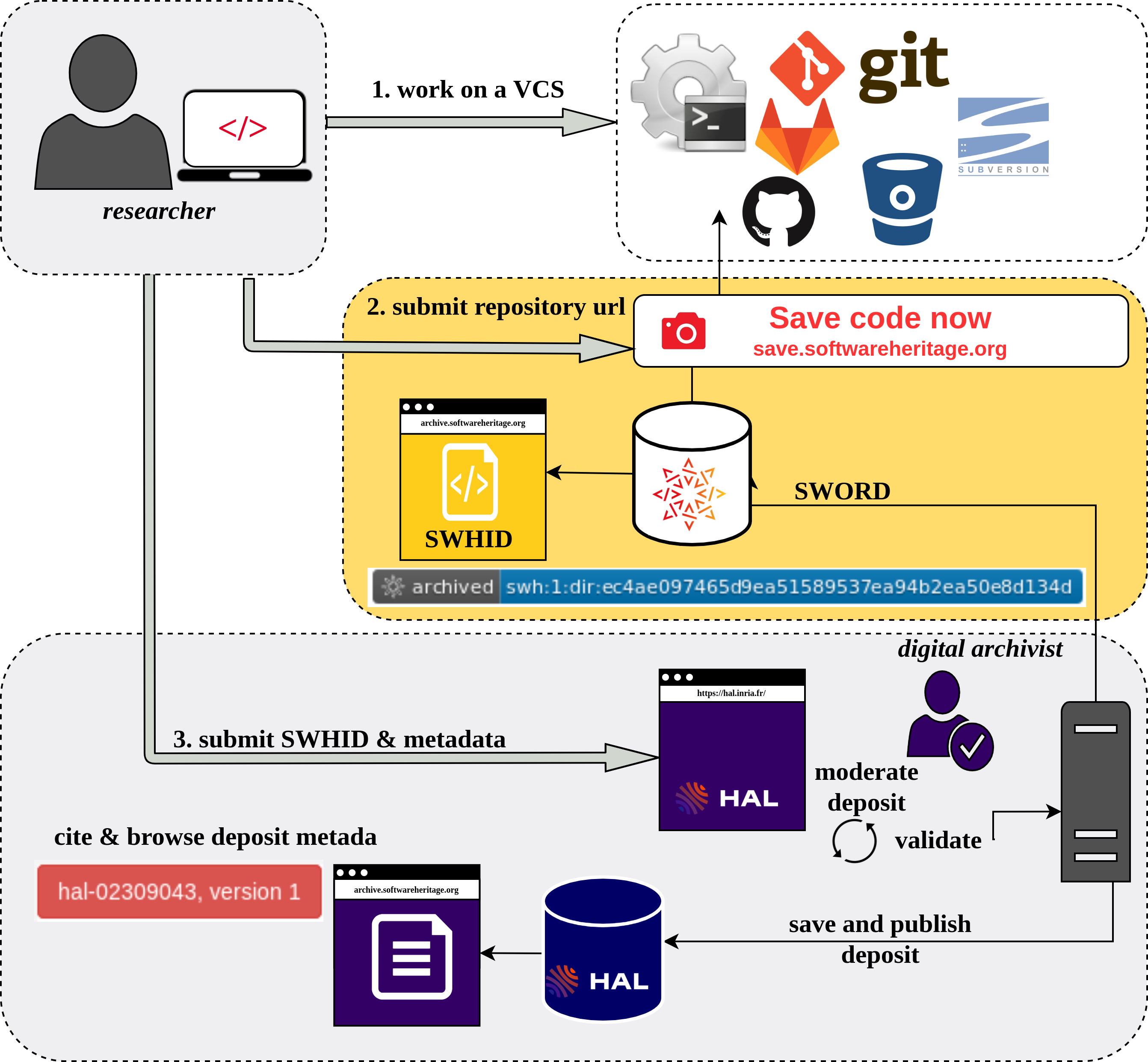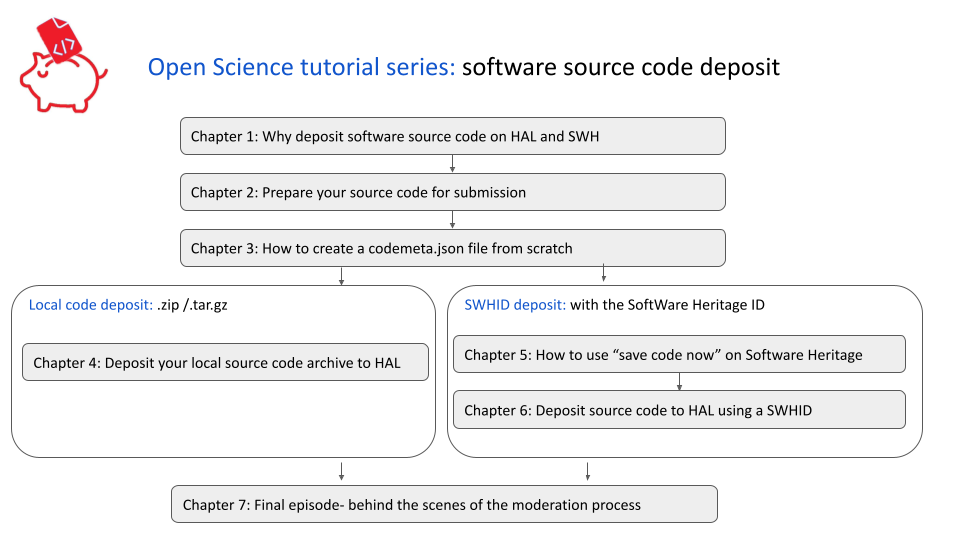The SWHID deposit: a new way to contribute research software to HAL

We are delighted to announce that the SWHID deposit for Research Software on HAL and Software Heritage is available on all HAL instances since January 2023. Thanks to a close collaboration between the CCSD, IES-INRIA and the Software Heritage team. The SWHID deposit is an addition to the already existing research software deposit as a compressed archive. The 2022 CCSD report has been released, highlighting the organization’s achievements and activities over the past year [1]. The report covers various aspects of CCSD’s work, including the software source code deposit.
Overview of the research software deposit
Why deposit research software?
Source code is fragile; it can disappear. It is important to note that software source code has an essential role in research and should be archived properly, alongside data and publications. Software that was built for research as part of the open science ecosystem should be archived, referenced, described and cited. When depositing in HAL you can describe a software artifact properly with specific metadata properties and fetch export formats (e.g BibTeX .bib file) to facilitate citation. Furthermore the source code will be safely saved in the universal software archive, Software Heritage.
What can be deposited in HAL?
Software source code that was developed in academia for research purposes (not executables) that its creators/authors wish it to be discoverable and archived on HAL and on SWH. Furthermore, Only the authors of their representatives can deposit software in HAL.
How to deposit ?
You can use two different methods:
- Local method: deposit .zip /.tar.gz
- SWHID method: deposit SWHID with metadata
First you should prepare your code. The HAL moderators are verifying the curation quality of the deposit, which means that the metadata on the record is compatible with the metadata found in the code.
Figure 1: The SWHID deposit workflow [2]
The research software deposit tutorials
To help researchers in their quest, we have prepared a playlist called the Open Science series: the software source code deposit on YouTube including seven short video tutorials to guide researchers using both the local sources method and the SWHID method.
Disclaimer: the videos were filmed in March 2022 with the previous HAL web user interface.
Figure 2: The table of contents of the Open Science series: the software source code deposit
Chapter 1: why deposit source code on HAL and Software Heritage
Chapter 2: Prepare your source code for submission
Chapter 3: How to create a codemeta.json file from scratch
Chapter 4: Deposit your local source code archive to HAL
In this chapter you will discover the local method and how to deposit a .zip on HAL.
Chapter 5: How to use “save code now” on Software Heritage and how to choose a SWHID for HAL
To use the SWHID method, first you need to do a «save code now» request and choose a SWHID, preferably a SWHID referencing the directory with the full context.
The SWHID deposit enables the possibility to archive the full development history on SWH while referencing a specific artifact for the HAL record and citation. Keeping the artifact in it’s context makes it easier to understand the evolution of the source code and the scientific result behind it [6].
Chapter 6: Deposit source code to HAL using a SWHID
After choosing a SWHID you can deposit the metadata in HAL using this SWHID on the first part of the HAL form. At the moment this method is only available on the HAL-Inria instance.
Chapter 7: Final episode- behind the scenes of the moderation process
If you are interested in seeing the moderation process, SWH in collaboration with IES-INRIA and the CCSD has prepared and updated in 2022 a detailed guide for moderators (in French) [7] and is supporting the training sessions organized by the CCSD.
You can find out more on the curation process in the IJDC article [5]
Checkout the behind the scenes video:
We hope tho see your deposits on HAL and in the Software Heritage archive…
References
- 2022 CCSD activity report https://www.ccsd.cnrs.fr/2023/03/ccsd-publication-du-rapport-d-activite-2022/
- Morane Gruenpeter, Jozefina Sadowska, Estelle Nivault, Alain Monteil. Create software deposit in HAL: User guide and best practices. [Technical Report] Inria; CCSD; Software Heritage. 2022. ⟨hal-01872189v2⟩
- A. Monteil, M. Gruenpeter, J. Sadowska, E. Nivault. Garantir la cohérence des données constitue le cœur de notre activité: entretien autour des enjeux descriptifs du code source. Bulletin des bibliothèques de France, Ecole Nationale Supérieure des Sciences de l’Information et des Bibliothèques (ENSSIB), 2021, Dossier BBF 2021-1 • Code source : libérer le patrimoine !. ⟨hal-03239502⟩
- Open Science tutorial series: software source code deposit (full playlist) includes 7 chapters about the source code deposit on HAL (https://hal.archives-
ouvertes.fr/) and on Software Heritage (https://archive. softwareheritage.org/). Morane Gruenpeter. 2022. https://youtube.com/playlist? list=PLD2VqrZz2- u3bOWtoCoBIh5Flt6iYXsq3 - R. Di Cosmo, M. Gruenpeter, B. Marmol, A. Monteil, L. Romary, J. Sadowska. Curated Archiving of Research Software Artifacts: lessons learned from the French open archive. IJDC. 2020 (10.2218/ijdc.v15i1.698). (hal-02475835)
- R. Di Cosmo, M. Gruenpeter, S. Zacchiroli Referencing Source Code Artifacts: a Separate Concern in Software Citation, CiSE, IEEE, pp.1-9. 2020. (10.1109/MCSE.2019.2963148) (hal-02446202)
- Sabrina Granger, Morane Gruenpeter, Alain Monteil, Estelle Nivault, Jozefina Sadowska. Modérer un dépôt logiciel dans HAL : dépôt source et dépôt SWHID. [Rapport Technique] Inria; CCSD; Software Heritage. 2022. ⟨hal-01876705v2⟩


